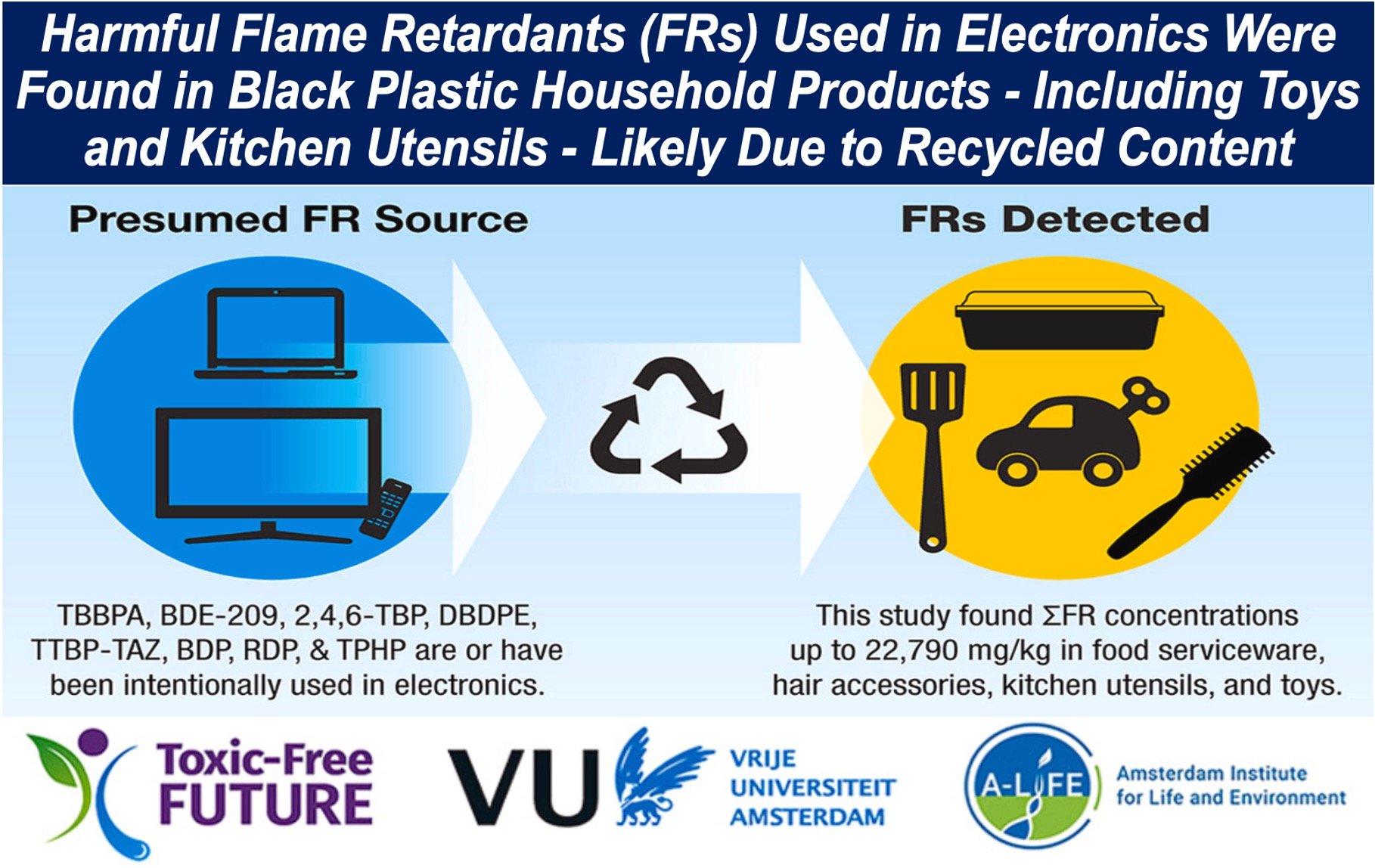Recent studies have raised alarming concerns about the presence of toxic flame retardants in black-colored plastic products, particularly kitchen utensils, toys, and food containers.
These harmful substances, once restricted to electronic products, are now being detected in household items due to faulty recycling practices.
A team of researchers from Toxic-Free Future in Seattle, USA, and the Amsterdam Institute for Life and Environment in the Netherlands wrote about their latest study and findings in the peer-reviewed journal Chemosphere (citation below).
Toxic Flame Retardants in Household Items
The research team revealed that black-colored plastic products, including kitchen utensils and takeout containers, contain high levels of brominated flame retardants (BFRs).
These toxic chemicals, once used primarily in electronics, have entered the consumer market through recycled materials, posing a significant health risk.
One of the most concerning findings was the presence of decabromodiphenyl ether (decaBDE), a flame retardant banned by the U.S. Environmental Protection Agency in 2021 due to its links to cancer, endocrine disruption, and reproductive toxicity.
Shockingly, decaBDE was found in 70% of the black plastic products tested, with levels far exceeding safety standards.

Health Risks of BFRs
BFRs are particularly dangerous due to their ability to persist in the environment and bioaccumulate in the human body.
Exposure to these toxic chemicals is associated with several severe health issues, including:
-
Carcinogenicity
Research has shown a strong link between flame retardants and various cancers. Individuals with the highest blood levels of polybrominated diphenyl ethers (PBDEs) were found to have a 300% increased risk of cancer compared to those with lower levels.
-
Endocrine Disruption
BFRs can interfere with hormone function, leading to issues such as thyroid disorders and developmental problems in children.
-
Neurotoxicity
These chemicals are also linked to neurodevelopmental issues, impacting cognitive and behavioral functions, particularly in young children.
-
Reproductive and Developmental Toxicity
Exposure to BFRs during pregnancy can lead to adverse effects on fetal development, including lower birth weight and developmental delays.
How These Toxic Chemicals Enter Our Homes
The recycling of e-waste, particularly electronics containing flame retardants, is a significant contributor to the contamination of household items.
Plastics from discarded electronics are repurposed into consumer goods like kitchen utensils, toys, and food containers, bringing harmful chemicals into our everyday environments.
Experts have emphasized that this contamination is primarily found in black-colored plastic items.
The study examined 203 consumer products and found that 85% contained toxic flame retardants. Items with the highest levels included black plastic spatulas, sushi trays, and children’s costume beads.
What You Can Do to Reduce Exposure
Although the recycling of electronics is intended to be a sustainable practice, it is inadvertently exposing consumers to harmful chemicals.
Here are steps you can take to reduce your exposure to BFRs:
-
Avoid Black Plastic for Food Contact
Experts recommend avoiding the use of black plastic kitchen utensils and food containers. Instead, opt for alternatives made from stainless steel, glass, or ceramic.
-
Do Not Microwave Food in Black Plastic
Heating food in black plastic containers can increase the risk of chemicals leaching into your food. Always transfer your food to safer materials before reheating.
-
Keep Your Home Clean
Regular dusting, mopping, and vacuuming can help reduce the amount of flame retardant particles in your home. These particles can attach to dust and be ingested, especially by children.
-
Wash Hands Frequently
Since these chemicals can be transferred to your hands through contact with contaminated items, regular hand washing is essential, especially before eating.
Final Thoughts
The presence of toxic flame retardants in everyday household items is a cause for concern.
While efforts are being made to address these issues through legislation and recycling regulations, it is crucial for consumers to be vigilant and take steps to reduce their exposure.
By making informed choices about the materials we use in our homes, we can help protect our health and the environment.
Citation
Ma, L., Ding, J., Zhou, L., Liu, M., & Stapleton, H. M. (2024). From e-waste to living space: Flame retardants contaminating household items add to concern about plastic recycling. Chemosphere, 366, 139998. https://doi.org/10.1016/j.chemosphere.2024.139998
